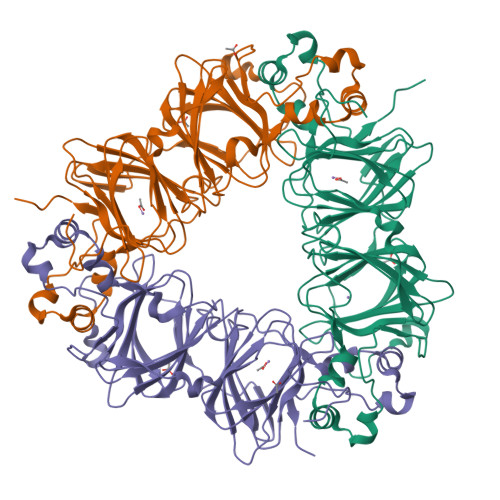Protein-Folding Location Can Regulate Manganese-Binding Versus Copper- or Zinc-Binding.
Tottey, S., Waldron, K.J., Firbank, S.J., Reale, B., Bessant, C., Sato, K., Cheek, T.R., Gray, J., Banfield, M.J., Dennison, C., Robinson, N.J.(2008) Nature 455: 1138
- PubMed: 18948958
- DOI: https://doi.org/10.1038/nature07340
- Primary Citation of Related Structures:
2VQA - PubMed Abstract:
Metals are needed by at least one-quarter of all proteins. Although metallochaperones insert the correct metal into some proteins, they have not been found for the vast majority, and the view is that most metalloproteins acquire their metals directly from cellular pools. However, some metals form more stable complexes with proteins than do others. For instance, as described in the Irving-Williams series, Cu(2+) and Zn(2+) typically form more stable complexes than Mn(2+). Thus it is unclear what cellular mechanisms manage metal acquisition by most nascent proteins. To investigate this question, we identified the most abundant Cu(2+)-protein, CucA (Cu(2+)-cupin A), and the most abundant Mn(2+)-protein, MncA (Mn(2+)-cupin A), in the periplasm of the cyanobacterium Synechocystis PCC 6803. Each of these newly identified proteins binds its respective metal via identical ligands within a cupin fold. Consistent with the Irving-Williams series, MncA only binds Mn(2+) after folding in solutions containing at least a 10(4) times molar excess of Mn(2+) over Cu(2+) or Zn(2+). However once MncA has bound Mn(2+), the metal does not exchange with Cu(2+). MncA and CucA have signal peptides for different export pathways into the periplasm, Tat and Sec respectively. Export by the Tat pathway allows MncA to fold in the cytoplasm, which contains only tightly bound copper or Zn(2+) (refs 10-12) but micromolar Mn(2+) (ref. 13). In contrast, CucA folds in the periplasm to acquire Cu(2+). These results reveal a mechanism whereby the compartment in which a protein folds overrides its binding preference to control its metal content. They explain why the cytoplasm must contain only tightly bound and buffered copper and Zn(2+).
Organizational Affiliation:
Cell and Molecular Biosciences, Medical School, Newcastle University, Newcastle NE2 4HH, UK.




















